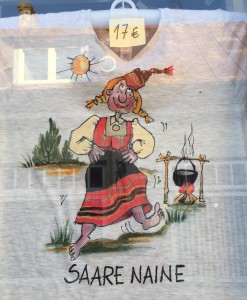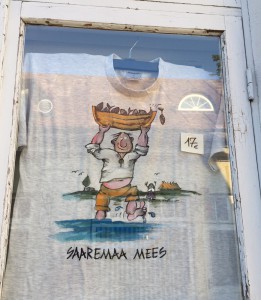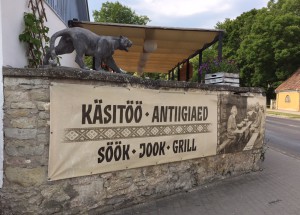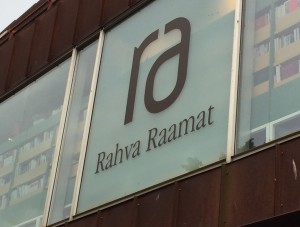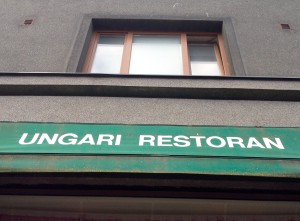Mis on sinu lemmiklause igas tunnis?
TÕLKED 1 – 5 = TRANSLATIONS (somewhat literal)
TUND 1 (= UNIT 1)
Dialoog 1
A: Good morning!
B: Hello/Hi!
A: How is it going (= How are you)?
B: Well, but what about you?
A: Thanks, not bad.
D2
A: Good afternoon! I’m Mart. Who are you?
B: I’m Tiina.
A: Very nice (= Nice to meet you). And where do you live?
B: I live in Viljandi.
D3
A: Hi! My name’s Tiiu Kivi (=Stone). What’s your name?
B: Hi, my name is Peeter Tamm (= Oak).
A: Very nice. Do you live in Tallinn?
B: Yes. But you?
A: I live in Tallinn, too.
D4
A: Good morning, Liisa!
B: My name is not Liisa.
A: Oh, I’m sorry, what’s your name then?
B: My name is Laura.
A: Very nice. I’m Kaarel.
Map of Estonia. Poem: Beautiful, beautiful, beautiful is the country. Beautiful is the country that I love.
Robert. Hello! This is me – Robert Roosipuu (=rose tree). I’m handsome, smart and kind. I’m a good/hardworking man. I live in Tallinn. Tallinn is located in Northern Estonia. Tallinn is a very beautiful and a very old city. Tallinn is the capital of Estonia. Estonia is a beautiful country.
Poem: Picture of a face/Portrait
An eye, an eye, a nose, a mouth,
a face round like a moon.
TUND 2
Map of Europe. Estonia, Latvia and Lithuania are the Baltic states. They are located at the Baltic Sea. Estonia’s capital is Tallinn. Latvia’s capital is Riga. Lithuania’s capital is Vilnius. The Swedes live in Sweden. The Finns live in Finland. The Poles live in Poland. The Latvians live at the Baltic Sea and speak Latvian.
D 1
A: Hello, let’s get acquainted. I’m Mari.
B: Hello, very nice, I’m Mark. I’m from Latvia.
A: Really? You speak Estonian quite well.
B: Oh, I only speak a little.
A: Do you live in Estonia?
B: Yes, I live in Tartu now.
D 2
A: Hi! I’m Anne-Liis.
B: Hi! I’m Erik.
A: Are you Finnish (= a Finn)?
B: No, I’m Swedish (= a Swede) but I live in Tallinn now.
A: You speak (= can) Estonian so well already.
B: I can (speak) a little, Estonian is very difficult.
D 3
A: Hello, Andrei!
B: Hi Kati! How are you?
A: Well, but/and you?
B: Not bad. I’m studying Estonian now.
A: Really? You are very good! You already speak a little.
B: Unfortunately, I don’t speak very well, but I understand quite a lot.
A: Yes, so it is, the Estonian language is not easy.
B: But please speak a bit slower.
D 4
A: Excuse me, do you speak Estonian?
B: Yes, I do.
A: Very nice, I am Russian, but I also speak a little Estonian.
B: Do you live in Russia?
A: No, now I live in Finland, but I was born in Russia.
B: Where have you studied Estonian then?
A: My grandmother is from Estonia. She teaches me her mother tongue.
Tekstid
My name is Kaarel. I’m Estonian. I’m from Pärnu. Pärnu is a very beautiful city. It’s located at the sea. My mother and father are also Estonians. They live in Pärnu. I speak (= able to speak) English, Russian and Finnish. I have studied English at school. Now I study at Tallinn Technical University. I’m a student.
I’m Sergei. I’m Russian but I was born in Estonia. I’m from Narva. Narva is located in Eastern Estonia. Narva is a very old city. Now I live in Tallinn. I study Estonian here. The Estonian language is quite difficult. Unfortunately, I don’t speak very well yet. I also speak a little Finnish and Polish.
TUND 3
D 1
A: Hi, Marika! How are you?
B: Fine, and you?
A: Not bad. I also live in Tallinn now.
B: Really! Where then?
A: On Sõpruse Blrd, in Mustamäe. And where do you live?
B: I live on Metsa Street, in Nõmme.
A: Please tell me your telephone number.
B: 55 622 709
A: I’ll call you then.
D 2
A: Hi, Peeter!
B: Hi, Anna! You’re here! Do you live in Estonia now?
A: Yes, I live in Tartu, on Riga Street. And where do you live?
B: I live in the center of town, on Rüütli Street.
A. Oh, I know where that is. What is your address?
B. 17-10 Rüütli Str. Are you studying or working?
A: I’m working. Call me or send email.
B: OK, I’ll call you. Good-bye!
D 3
A: Excuse me, is that you, Kersti?
B: Yes, and you are Marek! Hello, hello! How are you?
A: Fine. Why are you in Tartu?
B: I am studying at the music school here.
A: And where are you living?
B: I have a little apartment in Supilinn
A: On what street?
B: On Tähtvere Street.
D 4
A: Hello, Vladik!
B: Hello! Do you live in Tallinn now?
A: Yes, in Kopli.
B: Do you have a house or an apartment?
A: I have a quite big apartment.
B: What is your address?
A: 13-67 Sadama Str.
B: Is your e-mail address the same?
A: Yes, send me an e-mail.
TUND 4
D 1
A: Tiit, how many sisters and brothers do you have?
B: I have two brothers.
A: Where do your brothers live?
B: One lives in Viljandi and the other in Tartu.
A: What are their names?
B: Ott and Ants.
A: Do they also have children?
B: Ott does not, but Ants has two sons.
D 2
A: Do you have a sister or a brother?
B: Yes, I have three sisters.
A: Where do your sisters live?
B: Two live in Saaremaa and one lives in Finland.
A: What are their names?
B: Mari, Piret and Juuli.
D 3
A: Do you have a car?
B: No, I don’t have a car.
A: So, do you have a bicycle?
B: Yes, I have a new bicycle now.
D 4
A: Do you have a dog or a cat?
B: I don’t have a dog, but I have two cats.
A: What color are they?
B: One is black and the other is dark gray.
D 5
A: Do you like this blue color?
B: Not especially.
A: How about this light yellow?
B: I think this is quite pretty indeed.
D 6
A: What color flowers do you like?
B: White? But you?
A: I like red. Red is a color of love.
B: I think this is quite pretty indeed.
Robert talks of his family. Hi, I’m back, Robert Roosipuu! Now I will tell you who I am and what I have. I am from Pärnu. My mother and father also live in Pärnu now. Their house is on the edge of the sea. Pärnu has a very beautiful sea. I live in Tallinn, in Nõmme, now. I have a little yellow house on Vabaduse Street. I like the color yellow. My house’s number is 98.
I am married. I have a wife, Lilli. Lilli has blue eyes and blond hair. Lilli is also very beautiful, smart, and good. We have an old red car and two bicycles. My bicycle is green and Lilli’s bicycle is gray. We also have animals (=pets). We have one dog. Its [=his/ her] name is Portus. Portus is white. Portus very much likes hamburger. We also have two cats. One is black and the other is orange. Their names are Miks and Maks. The cats love chocolate. Of course, Lilli also loves chocolate.
TUND 5
D 1
A: What time is it?
B: Eight-thirty (8:30).
A: Eight-thirty already?
B: Yes, get up quick! The class starts already at nine o’clock.
D 2
A: What time does your work start today?
B: Eight o’clock.
A: But it’s already seven fifteen (7:15).
B: Oh my! Then I’m really going to be late.
A: Don’t worry, you have 45 minutes time.
D 3
A: Hi! When does the next bus go to Kuressaare?
B: At 2:30.
A: How much does a ticket cost?
B: 15 euros.
A: Two tickets for me, please.
B: Are you paying by card or in cash?
A: By card.
D 4
A: Excuse me, when does the last bus go to Haapsalu?
B: Just a moment, please. At nine forty-five.
A: And how much does a ticket cost?
B: Seven euros and fifty cents.
A: Then please give me one student’s ticket.
B: Here you are. The bus goes from bus stop 12.
D 5
A: Do you know how many kilometers it is from Tallinn to Kuressaare?
B: I don’t know exactly, but I think it’s about 200.
A: And do you know how long the bus travels to get there?
B: Maybe four and a half hours.
D 6
A: I am going to Tartu tomorrow.
B: What time are you going?
A: Seven-thirty.
B: Who are you going with?
A: With Heidi.
B: How are you going?
A: By bus, but we are coming back by train.
B: What time will you come home at night?
A: About ten-thirty. (= About half past ten.)
D 7
A: What are you doing this weekend?
B: I’m probably going to Saaremaa.
A: How are you going there?
B: By (=with) a friend’s car.
A: And how long will you be there?
B: Probably five days. Come with us, too!
A: A good idea. But l’ll see how the weather is. If the weather is bad, then I won’t come.
B: OK, then, we will call.
KEELETARK 1
1. Verb to be
sa = informal, te = informal plural + formal singular.
tubli is a specific adjective = good at doing something, also diligent/hardworking
plural – tubli/d
2. Verb endings in present
All verbs (except olema = to be) have the same endings in present tense — 100% rule.
3. Personal pronouns
Normally, short forms of personal pronouns (ma, sa, ta etc) are used. Long forms are used only when emphasizing the pronoun.
Ma olen itaallane. vs Kas ta on hispaanlane? Ei, ta on itaallane. Mina olen hispaanlane.
4. Negative verb forms
When ei = no is used to form negative sentences, the corresponding verb forms have no personal endings.
Ma (sa/ta/me/te/nad) ei ela Tallinnas.
5. kus? = IN where – two endings
The ending -S is more common. In general, -S means in something and -L means on something.
Place names with the ending -MAA (=land) take -L: SaaremaaL, HiiumaaL;
endings -MÄE (=hill) , -JÄRVE (=lake) also take -L, but they are not so common: MustamäeL, Kohtla-JärveL.
6. he/she is; they are = ta on; nad on
7. Pronunciation
No need to worry if your pronunciation of Õ is not perfect. In the Saaremaa dialect, we don’t have this sound at all: i.e. õ = ö. If not perfect – move to Saaremaa.
ÜLDISED KOMMENTAARID. TUND 1 ,
1. Estonian names
No gender suffixes in first or last names. First names usually don’t have a meaning, but the majority of the last names do mean something.
2. Two infinitives = two basic forms
Just notice there are two infinitives (-ma-inf., -da-inf.) in verb boxes.
Wait until unit 6 to learn how to use them.
3. Pronounciation
In general, Estonian is pronounced according to spelling. Exceptions: d = [t], b = [p], g = [k]
4. Word order
Word order is relatively free in Estonian. Often it’s just a question of style. There are some rules, of course, but at the beginner’s level there is no need to worry or think about the word order at all. Just observe how sentences are formed.
5. Similar words
nägu = face väike = small, little
nagu = as, like päike = sun
KEELETARK 2
1. Changes in verb stem in the present tense
Many verbs have stem changes in present in comparison with infinitive, just remember these verbs as they appear in the textbook. The change applies to all the present tense forms.
NB! loen raamatut, räägin eesti keelt, õpin saksa keelt = 3. forms, learn as phrases
2. kus? = IN where; kust? = FROM where
endings -S/-ST, -L/-LT always coincide
3. Compound verbs
The word order changes, why? – no good explanation.
4. Expressions with olema = to be
NB! Literal translation: I am born, I am studied.
5. Nationalities
Forming nationalities is regular and easy: suffix –LANE for singular,–LASED for plural.
poolaKAS is an irregular form.
6. No capital letters (täht = letter)
There are not as many capital letters in Estonian as in English or German, for example.
NB!!!! No capital letters in nationalities, languages, weekdays, months.
ÜLDISED KOMMENTAARID. TUND 2
1. ääres – at something
mere ääres, järve ääres
2. oskama – only skill, ability to do something (speak a language, ski, skate etc).
KEELETARK 3
1. Personal pronouns
mina/ma = I
minu maja = my house
mul on maja = I have a house
helista mulle = call (to) me
2. Addresses
Street name always before house/building No.
maja = house, building
3. Imperatives (orders, requests)
SA – singular is very easy – always present tense stem without personal endings.
TE – plural has two endings -KE and -GE. Since no difference in pronunciation, no need to worry which one to use. And no sense to wonder where these forms come from.
Tip: in exercises, just guess, check your answers with the key and remember the forms.
ütlema – an exceptional and complicated verb, has two second infinitives and two imperatives. Just remember, no need to contemplate.
ma loe/n sa loe! te luge/ge!
ma ütle/n sa ütle! ütel/ge! = öel/ge!
ÜLDISED KOMMENTAARID. TUND 3
1. Singular verb form with numbers
Tallinnas elaB 400 000 inimest. Elavad is not considered correct but will not be a huge mistake for beginners. No explanation, take it as a phrase
2. matemaatika
7+4 = 11 Küsimus: Kui palju on seitse pluss neli?
3. Kuidas läheb? = Kuidas sa elad? NB! two expressions, same meaning but different reply.
4. Luuletus Väike konn
Good practice for such complicated words as väike and ütlema.
Very important to learn the poem by heart both in singular and plural.
väike, väikese = väikse, väiksed
ütle! – öelge!/ütelge!
KEELETARK 4
1. Three forms of nouns and adjectives
Unit 4 gets a bit more complicated but don’t worry, it’s just an introduction, no need to memorize all these forms and endings. Yes, there are 14 cases in Estonian but in our textbook, we mention only the first three. The others are taught in phrases and with the help of questions: kus? kust? kellega? etc.
Starting from the 4th unit the first three forms of all new nouns and adjectives appear in the margins. Don’t try to memorize all the forms immediately. Margins are helpful while doing exercises. There are no rules for these endings. Later you will notice that there are groups of words that behave similarly.
The meaning of the first three cases/forms of nouns and adjectives:
1st form = nimetav = nominative – naming
2nd form = omastav = genitive – whose, possession
3rd form = osastav = partitive – action, feelings, emotions directed towards somebody or something + number expressions.
In the margins, there are letters marked as bold and underlined – these are pronounced prolonged and stretched but this is not an issue that needs special attention. Just imitate pronunciation while listening to dialogues and poems.
2. Simple plural = 1st form/nominative in plural
sing. 2. form/genitive + D = 1. form pl. – 100% rule.
1. form sing. tark poiss 1. form pl. targa+d poisi+d
2. form sing. targa poisi nimi
Meaning: Targad poisid õpivad hästi.
NB! CALL IT 3D RULE – No 1 AND THE SIMPLIEST RULE IN THE ESTONIAN LANGUAGE.
3. Number case = singular partitive = 3. form
It’s important to distinguish between number expressions which take the 3rd form singular (kaks lauda) and so called simple plural (=1. form plural.) (neeD on minu lauaD = laua+D).
Both of these are 100% rules.
Number üks takes nominative.
There are three groups of endings in partitive singular: -T, vowel and -D.
The rule for –D ending (limited group — 12-15 words): one syllable, ending with a double vowel (maa, töö, tee) or two different vowels (pea, hea).
How to distinguish between the T-ending and the vowel ending? No rules.
NB!!! Words in the –D group have the same ending in simple plural and number case: need on ilusad maaD; kaks ilusat maaD.
4. Negative
Negative always takes 3. form. Exception: meeldima — mulle ei meeldi see korter (1. form).
5. kelle? = whose? = 2. form
Genitive always ends with a vowel.
Often students overlook this case. Pay attention. Take these as phrases or chunks:
NB!!!! venna maja, õe korter, mehe nimi, naise nimi, lapse nimi, sõbra auto, koera nimi
6. kelle/l on? = who has; ending -L
kelle/l ei ole? = who doesn’t have
7. kellele meeldi/vad? = who likes? = to whom it pleases; ending -LE
NB!!!! mulle meeldiB punane auto (üks). Mulle meeldiVAD punased autoD (mitmus).
8. ära – ärge = don’t
sa ära loe! te är/ge luge/ge! = don’t read, singular and plural
ÜLDISED KOMMENTAARID. TUND 4
1. The most important expressions in unit 4
Mul on kaks venda. = I have two brothers.
Mulle meeldib sinine. = I like blue. (= Blue is pleasing to me.)
Mulle meeldivad sinised lilled. = I like blue flowers.
2. The most important words in unit 4
õde, vend, naine, mees, laps, sõber, kass, koer.
3. mitu?
Mitu vihikut sul on? Mul on kolm vihikut.
Mitu and numbers require the same case (partitive).
mitu also means several: Mul on Eestis mitu head sõpra.
4. Mis värvi lilled…?
Mis värvi lilled sulle meeldivad? = Flowers of what color …
Hard to explain why partitive (värvi) is used here. Take it as a set phrase.
5. Ma arvan, ET … – very important phrase, always comma + et
6. The questions lead to the answers
NB!!!! Keep the endings of q-s also in the answers:
Mitu autoT suL on? MuL on üks auto/kaks autoT.
Mis värv sulLE meeldib? MulLE meeldib kollane.
7. similar words
puu – kuu – suu see – tee
kool – tool uus – kuus
8. Luuletus Vari
Good practise for long vowels: vaata, nüüd – stretch as much as you can.
ma seisan ta jalgade peal = I’m standing on its feet = on shadow’s feet; ta = tema
Vari was a popular song in the eighties performed by father and son Väino and Toomas Uibo. You can find the song on their CD and in YouTube:Vari. Väino ja Toomas Uibo.
KEELETARK 5
1. minema, sõitma
minema – ma lähen The only verb that has two totally different stems for the infinitive and present tense.
sõitma = go by vehicle
minema = general: go by vehicle or on foot
2. kuhu? = to where?
NB!!!!! THIS IS No 1 KEY ISSUE IN ESTONIAN:
kuhu? = TO where; kus? = IN where; kust? = FROM where.
NB!!!! Endings for kuhu? -SSE, -LE, — (0-ending = no ending)
There are no rules when to use 0-ending instead of -SSE. Just memorize.
Tip: elan PiritaL — lähen PiritaLE (-L, -LE always coincide).
Sometimes parallel forms are possible but short forms are more common.
lähen Tallinnasse/Tallinna, Lätisse/Lätti, Haapsalusse/Haapsallu
Some examples of 0-endings:
Ma lähen
Amsterdami New Yorki Berliini
Bonni Washingtoni Budapesti Rooma
Frankfurti Viini Stockholmi Riiga
Hamburgi Pariisi Lissaboni Kadriorgu
Luxemburgi Peterburgi Madridi
3. minema (kuhu?) – käima (kus?) – tulema (kust?)
NB!!!!!! THIS IS No 2 KEY ISSUE IN ESTONIAN:
minema = to go in one direction, käima = routine; to go back and forth, tulema = to come
It takes some time to understand when to use käima and minema.
Learn the expressions in Keeletark as set phrases.
4. when? = millal? – in the answers also -L
ööse/l – a strange form, just remember
5. mille/ga? kelle/ga?
go with/by train – with a friend, the same logic
ÜLDISED KOMMENTAARID. TUND 5
1. kellaaeg = time
So-called army numbers (13-24) are not used with veerand/pool/kolmveerand.
2. similar words
sinna – linna
viima – piima
üks – uks
ma tean – ma teen (teadma = to know, tegema = to do/make)
3. Luuletus Piimaauto
Good practice for long vowels. NB! different length of i: piimaauto veab piima
Helps to remember siia – sinna ((to) here – (to) there)
These phases have to be clear as mud before you go on to the next unit.
Of course, it’s better to modify the phrases according to your personal information and learn them then.
Tund 1
1. Kuidas läheb?
2. Hästi, aga sinul?
3. Mis sinu nimi on?
4. Kus sa elad?
5. Ma elan Tartus.
6. Kus Tartu asub?
7. Tartu asub Lõuna-Eestis.
8. Eesti pealinn on Tallinn.
9. Tallinn asub Põhja-Eestis.
10. Ma olen ilus, tark ja hea.
Tund 2
1. Ma elan Prantsusmaal.
2. Ma olen sündinud Pariisis.
3. Ma olen prantslane.
4. Minu emakeel on prantsuse keel.
5. Ma oskan ka natuke eesti keelt.
6. Ma õpin eesti keelt keeltekoolis.
7. Kahjuks ma ei räägi veel väga hästi.
8. Eesti keel on raske, aga ilus keel.
9. Minu vanaisa on pärit Eestist.
10. Ma ei saa aru.
Tund 3
1. Kuidas sa elad?
2. Hästi, aga sina?
3. Mis on sinu aadress?
4. Minu aadress on Mere pst 23-15.
5. Ma elan Mere puiesteel.
6. Mul on väike korter.
7. Kas sa õpid või töötad?
8. Ma töötan ja õpin ka.
9. Helista mulle homme.
10. Saada mulle meil.
Tund 4
1. Mitu õde ja venda sul on?
2. Mul on üks õde ja kaks venda.
3. Nende nimed on Karl, Mark ja Laura.
4. Minu venna nimi on Karl. (1)
5. Minu õe nimi on Laura. (1)
6. Mul on Eestis kaks sõpra.
7. Minu sõbrad elavad Pärnus.
8. Mul ei ole kassi või koera kodus.
9. Mul ei ole autot, aga mul on jalgratas.
10. Mulle meeldivad sinine ja roheline.
Tund 5
1. Kell on kolmveerand seitse.
2. Mul on eesti keele tund igal reedel.
3. Millal on järgmine eesti keele tund?
4. Tavaliselt ma tõusen üles kell kuus.
5. Ma lähen tööle kell pool üheksa.
6. Kuidas sa tavaliselt tööle lähed?
7. Ma lähen tööle bussiga.
8. Ma sõidan 15 minutit/veerand tundi.
9. Töö algab kell üheksa.
10. Mis see pilet maksab?
11. Palun mulle üks üliõpilase pilet.
12. Kui kaua sõidab buss Tallinnast Pärnusse?
Now it’s time to venture into the real world. Practice your reading and comprehension skills by looking at the following photos of signs. Do you know what they say? Can you figure it out?
SAMPLE STUDENT’S ESSAY WITH TEACHER’S CORRECTIONS
MINA
Mina olen Ankur. Ma ei ole väga tark, aga olen hea ja sõbralik. Ma olen pärit Indiast: olen sündinud Barodas. Baroda on suur linn, see asub Lääne-Indias. Ma elan praegu Pariisis, mul on väike korter kesklinnas. Mu korter on hall. Ma ei armasta ??hall. Mul on kaks jalgratast. Ma õpin praegu Internetis eesti keelt: oskan ainult natuke eesti keelt, aga mulle meeldib JUBA väga juba eesti keel. Mu õpetaja on väga hea ja tubli. Tema nimi on Mall. Mu emakeel on hindi keel, aga räägin ka inglise ja prantsuse keelt. Ma õpin ja töötan: leian MA ARVAN, et see on raske.
Mu vanemad elavad Indias. NAD HELISTAVAD Mulle helistavad iga päev. Mu ema on väga hea ja ilus. Mu isal on suur nägu, ta ei ole ilus. Mul on üks õde. ??Mu ei ole venda. Mu õde on abielus ja tal on kaks last. Nemad on väga ??tark. Mul on kaks kassi. Üks on valge ja teine on must – nagu mu vana televiisor. Aga mu meelest = MA ARVAN, ET on väga ilusad mu kassid.
Nii, see on kõik.
Oled väga tubli, mulle väga meeldib see jutt (=STORY).
It’s better to use mulle ei meeldi hall (värv); armastama is a strong word in Estonian and is normally not used with likes/dislikes. And besides – mulle meeldib + always 1. form – much easier.
Suur aitäh! Mall
Teacher’s comment
The assignment for students was to write about themselves using only words and phrases from units 1-4. This is an example of a very well-written essay written by an online student after completing the 4th unit.
I didn’t correct mistakes but used ?? in front of a wrong word instead (only in cases beyond student’s knowledge a correct word or form is added) so that students have to correct themselves while writing the second version. There are two words the student has looked up in the dictionary which are not in units 1-4: a) leian = find – not at all necessary to use this word, since MA ARVAN is clearly preferable here; b) mu meelest = to my mind, also not necessary; again, MA ARVAN is simpler, more frequent and is the vocabulary word that needs to be learned in unt 4.
I like this essay even more after getting an e-mail from Ankur saying he would be “making up more crazy sentences about these imaginary cats next time”. 🙂

